I wanted to get down to brass tacks and review the state of the affordable housing situation in California and the broader US – in numbers. The National Low-Income Housing Coalition (NLIHC) has published its 2022 edition of Out-of-Reach, its annual report documenting the gap between renters’ wages and the income needed to rent at fair-market rates, and I wanted to share some important findings.
As you might expect, the numbers are not improving. From the beginning of 2021 to the beginning of 2022, rents increased by 15% nationwide, or $179. This increase is 4.5 times higher than any yearly increase in the last four years. Unfortunately, the minimum wage is not keeping up. A worker earning the federal minimum wage of $7.25 must work 3.5 full-time jobs to afford a 2-bedroom apartment at the national average fair-market rate while saving 70% of their income for other necessities. In California, a worker earning the minimum wage of $15 must work 2.6 full-time jobs to afford a 2-bedroom rental home and 2.1 full-time jobs to afford a 1-bedroom rental home at California fair-market rates. This means that even a couple working full-time at minimum wage cannot afford a 1-bedroom rental home! Here in San Francisco, a full-time worker must work four full-time jobs (160 hours a week!) to afford a 2-bedroom in the city. The American dream is sounding more like an American fantasy.
How much of the working population can actually afford a 2-bedroom apartment at fair-market-rate in their city? It turns out that more than 40% of all workers in the US, excluding farm workers, work in industries that don’t pay enough to afford a one-bedroom apartment in their own city. 40% of our nation’s working population can’t afford a 1-bedroom apartment! And 60% can’t afford a 2-bedroom apartment.
A significant driver of the recent rent increases has been the surge in demand during the pandemic. Around 870k individuals entered the rental market during the pandemic, contributing to a very low 5.8% vacancy rate. Many of these newcomers were higher-income individuals who could afford to pay more than fair-market-rate for a rental unit but could not compete in the home-buying market. As a result, landlords drove up prices, knowing that many would-be renters would be willing to pay while pricing out low-income workers.
Another contributor to high rents has been the increased number of purchases of rental developments by investors. Investors purchased more than 80K homes in the last quarter of 2021 – the highest number of purchases for any quarter seen since 2000. When corporate investors take over rental property, it is common practice for them to increase rents, especially in units where rents were initially low. Corporate investors are also extremely quick to file evictions when households miss the monthly payment.
The supply of affordable housing needs to increase. Cities can accomplish this by building additional units allocated to affordable housing and ensuring that existing affordable housing remains attainable by lower-income workers. As supply and demand for expensive rental units trend upward, the lower-income face fewer housing options. And the ones who can hang on to housing often have little to no savings to make the rent in times of sudden financial hardship. So many renters are just one paycheck from homelessness. We need to establish rental assistance programs for those who need emergency assistance to save them from speedy evictions.
And let’s not forget that losing your home is a terrifying experience. Eviction causes intense mental anguish for the victims and their children. It is heartbreaking to realize that working one, two, three, or even four full-time jobs at minimum wage here in the Bay Area is not enough to spare you from that experience.







